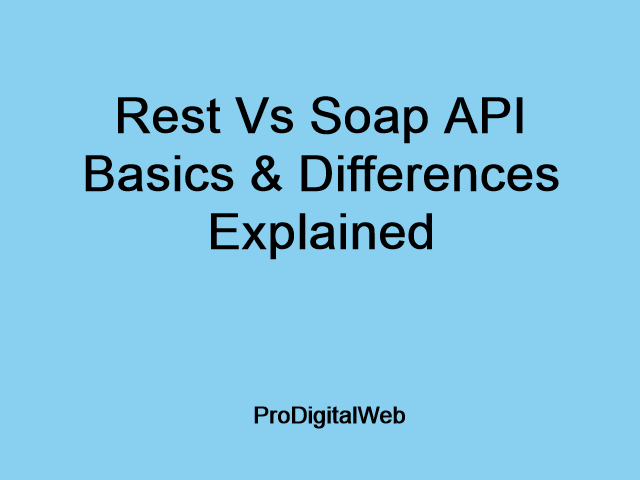Want to know about REST vs SOAP? It is pretty hard to choose one among these two. Let’s have a look at the details of these two and their differences.
What is Soap?
Soap is the acronym of Simple Object Access Protocol. It is a standards-based web services access protocol that Microsoft developed.
SOAP API Overview:
It depends on XML mainly for offering messaging services. Microsoft invented the protocol to take the place of earlier technologies like Distributed Component Object Model (DCOM) and Common Object Request Broker Architecture (CORBA). You cannot use the old technologies as these depend on binary messaging. This XML messaging can be used better over the internet.
When it was released, Microsoft had given it to the Internet Engineering Task Force (IETF) for standardization. It comes with different other acronyms like WS-Addressing, WS-Policy, WS-Security, WS-Federation, WS-ReliableMessaging, WS-Coordination, WS-AtomicTransaction, etc., and WS-RemotePortlets. However, a complete list of these types of standards can be available on Web Services Standards.
It is extensible highly, but you can use merely your required pieces. For instance, if you use a free public web service, there is no need to have WS-Security.
Difficulty relies on Programming Language:
The XML is used to make requests and get responses. But it can be complex sometimes. You should know one thing is that there are a few programming languages where you have to build the requests manually. But it can cause issues as the protocol is intolerant of errors. You can use another language that uses shortcuts and help to decrease the effort necessary for making the request and parsing the response. While you deal with .NET languages, you never find XML.
WSDL or Web Services Description Language is another type of file related to it. It lets you know the process of working on the web service. Thus, the IDE is capable of automating the process whenever you try to generate a reference to it. Therefore, how you use the protocol relies on the Language excessively.
Built-In Error Handling:
It is one of the great features of the protocol. Whether there exists an issue with your request, the response will hold the error details that are useful for solving the problem. Besides, you are not required to use this with the HTTP transport. A specification is there due to which this protocol is used over SMTP, Simple Mail Transfer Protocol. Developers are performing great in some languages like Python and PHP.
Advantages of SOAP API:
The benefits of the protocol over the other one are as follows:-
- It doesn’t depend on Language, platform, and transport.
- You should use it in distributed enterprise environments, whereas the other one offers direct point-to-point communication.
- It offers pre-build extensibility in the WS* standards form.
- This one features built-in error handling.
- It performs automation while you use language products.
When to use SOAP API?
People can use the protocol in such cases:
Asynchronous processing: Sometimes, customers want to have reliability and security of a guaranteed level. In this case, use the standard of 1.2. It can offer plenty of extra features while you discuss security.
A formal means of communication: Is there any agreement done between client and server? Hence, you can use the 1.2 version because it offers rigid specifications. Online shopping sites are an instance in this case where people can keep their items in a cart before payment.
Stateful operations:
The app may want to maintain its state from one request to another. If it is the case, then the 1.2 standards can be used. It also offers the WS* structure support.
Challenges in SOAP API:
Both customer and the server offer this. You should know the browser offers the term when it comes to clients.

WSDL file: WSDL document is a challenge itself. It lets us know about the operations that web service needs to perform. There are different types of information, like the data types used in the messages, and these are available through the web service.
Here, we have given a part of the WSDL file.
<?xml version=”1.0″?>
<definitions name=”Demo”
targetNamespace=http://demo.prodigitalweb.com/demo.wsdl
xmlns:tns=http://demo.prodigitalweb.com/demo.wsdl
xmlns:xsd1=http://demo.prodigitalweb.com/demo.xsd
xmlns:soap=http://schemas.xmlsoap.org/wsdl/soap/
xmlns=”http://schemas.xmlsoap.org/wsdl/”>
<types>
<schema targetNamespace=http://Demo.prodigitalweb.com/demo.xsd
xmlns=”http://www.w3.org/2000/10/XMLSchema”>
<element name=”DemoNameRequest”>
<complexType>
<all>
<element name=”DemoName” type=”string”/>
</all>
</complexType>
</element>
<element name=”DemoIDRequest”>
<complexType>
<all>
<element name=”DemoID” type=”number”/>
</all>
</complexType>
</element>
</schema>
</types>
According to the file, there are other elements named “Demo .”It is of string type and a part of DemoNameRequest.
If the file needs to challenge business requirements, it becomes TutorialDescription. It indicates that customers connected to the web services should change their code for accomodating in the WSDL file.
Document size: It is the largest challenge of the WSDL file. A single change of the file can cause a major impact. The size of the messages is another challenge that is transferred from the customer to the server. You are unable to use it for big messages where bandwidth will be available as a constraint.
A Simple Example:
Request from the client:
https://www.prodigitalweb.com/cgi/websvccal.cgi HTTP/1.1
Accept-Encoding: gzip,deflate
Content-Type: text/xml;charset=UTF-8
SOAPAction: “https://www.prodigitalweb.com/Calendar#easter_date”
Content-Length: 479
Host: www.prodigitalweb.com
Connection: Keep-Alive
User-Agent: Apache-HttpClient/4.1.1 (java 1.5)
<?xml version=”1.0″?>
<soapenv:Envelope xmlns:xsi=”http://www.w3.org/2001/XMLSchema-instance”
xmlns:xsd=”http://www.w3.org/2001/XMLSchema”
xmlns:soapenv=”http://schemas.xmlsoap.org/soap/envelope/”
xmlns:cal=”https://www.prodigitalweb.com/Calendar”>
<soapenv:Header/>
<soapenv:Body>
<cal:easter_date soapenv:encodingStyle=”http://schemas.xmlsoap.org/soap/encoding/”>
<year xsi:type=”xsd:short”>2014</year>
</cal:easter_date>
</soapenv:Body>
</soapenv:Envelope>
The response from the service:
HTTP/1.1 200 OK
Date: Fri, 22 Nov 2013 21:09:44 GMT
Server: Apache/2.0.52 (Red Hat)
SOAPServer: SOAP::Lite/Perl/0.52
Content-Length: 566
Connection: close
Content-Type: text/xml; charset=utf-8
<?xml version=”1.0″ encoding=”UTF-8″?>
<SOAP-ENV:Envelope xmlns:xsi=”http://www.w3.org/2001/XMLSchema-instance”
xmlns:SOAP-ENC=”http://schemas.xmlsoap.org/soap/encoding/”
xmlns:SOAP-ENV=”http://schemas.xmlsoap.org/soap/envelope/”
xmlns:xsd=”http://www.w3.org/2001/XMLSchema”
SOAP-ENV:encodingStyle=”http://schemas.xmlsoap.org/soap/encoding/”>
<SOAP-ENV:Body>
<namesp1:easter_dateResponse
xmlns:namesp1=”https://www.prodigitalweb.com/Calendar”>
<s-gensym3 xsi:type=”xsd:string”>2014/04/20</s-gensym3>
</namesp1:easter_dateResponse>
</SOAP-ENV:Body>
</SOAP-ENV:Envelope>
This example lets you know that it is sent over the http protocol. Besides, you can send over other protocols like HTTP, SMTP, TCP, or JMS. The message needs to be XML-formatted. The format needs two elements hence that are the Header and the Body.
The Soap web service looks like this:
<?xml version=”1.0″?>
<definitions xmlns:tns=”https://www.prodigitalweb.com/Calendar”
xmlns:soap=”http://schemas.xmlsoap.org/wsdl/soap/”
xmlns:xsd=”http://www.w3.org/2001/XMLSchema”
xmlns=”http://schemas.xmlsoap.org/wsdl/”
name=”Calendar” targetNamespace=”https://www.prodigitalweb.com/Calendar”>
<message name=”EasterDate”>
<part name=”year” type=”xsd:short”/>
</message>
<message name=”EasterDateResponse”>
<part name=”date” type=”xsd:string”/>
</message>
<portType name=”EasterDateSoapPort”>
<operation name=”easter_date” parameterOrder=”year”>
<input message=”tns:EasterDate”/>
<output message=”tns:EasterDateResponse”/>
</operation>
</portType>
<binding name=”EasterDateSoapBinding” type=”tns:EasterDateSoapPort”>
<soap:binding style=”rpc” transport=”http://schemas.xmlsoap.org/soap/http”/>
<operation name=”easter_date”>
<soap:operation soapAction=”https://www.prodigitalweb.com/Calendar#easter_date”/>
<input>
<soap:body use=”encoded” namespace=”https://www.prodigitalweb.com/Calendar” encodingStyle=”http://schemas.xmlsoap.org/soap/encoding/”/>
</input>
<output>
<soap:body use=”encoded” namespace=”https://www.prodigitalweb.com/Calendar” encodingStyle=”http://schemas.xmlsoap.org/soap/encoding/”/>
</output>
</operation>
</binding>
<service name=”Calendar”>
<port name=”EasterDateSoapPort” binding=”tns:EasterDateSoapBinding”>
<soap:address location=”https://www.prodigitalweb.com/cgi/websvccal.cgi”/>
</port>
</service>
</definitions>
Here, we have given all the message parts. There is also a thing to note that you may find the document as intended and read by PC. However, you can follow a few programming knowledge as it is easier to follow.
What is Rest API?
Representational State Transfer or Rest is designed for SOAP’s shortcomings. It is made in a way to solve the issues with soap. This one offers a more straightforward process to access web services.
Rest Overview:
It is a lighter-weight alternative. Multiple developers are unable to use the protocol easily. For instance, if you work with the protocol in JavaScript, it indicates that you should type plenty of codes to perform simple tasks as XML structure is always essential.
But it doesn’t use XML; instead, it generally depends on a standard URL. Sometimes, you may need to give extra details, but web services use this depending on the URL. It can use four different HTTP 1.1 verbs: GET, POST, PUT, and DELETE.
Web services hence provide an output of the data in Command Separated Value (CSV), JavaScript Object Notation (JSON), and the Really Simple Syndication (RSS). Here, the output can be obtained in the form you need.
Advantages:
It is simple to use and is more flexible. The benefits over the protocol are as follows:
- It doesn’t need any expensive tool to interact with the web service
- This one comes with a smaller learning curve and uses smaller message formats.
- It is quick enough and closer to web technologies when it comes to design philosophy.
When to use Rest API?
The most debatable topic is when you should use this. The key factors let you know when they should be used.
Limited resources and bandwidth: It needs to be used in places where the network bandwidth is a constraint as messages of the Access protocol take greater bandwidth.
Statelessness: Whether you are not willing to maintain a data state from one request to another, then you can use this. But if you want one request to flow into another, then the other one is better. Suppose you use an online purchasing site. Hence, you have to add the items to the cart, those you are willing to purchase. Next, the cart items are transferred to the payment page to finish the payment method. In this case, you can realize that the state feature is required. After that, you have to transfer the state of the cart items to the payment page to continue the process.
Caching: People who want to cache plenty of requests should use this perfect solution. When you implement a cache, you can store the frequent queries results that are mostly seen in an intermediate place. If any customer requests a resource, it checks the cache first. If the resources are already present, they won’t proceed to the server. Therefore, you can reduce the number of trips by caching.
Ease of coding: You should use this one for a quick win solution.
Challenges in Rest API:
Lack of Security: You should know that it never imposes any security like the protocol. It is the reason due to which the REpresentational State Transfer is the right choice for the URL. But it should not be used if you want to pass any confidential information between the client and the server.
Lack of state: In most cases, web apps need a stateful mechanism. For instance, a purchasing site has a shopping cart and a mechanism. Hence, you should know the item numbers you save in the shopping cart. But this state is available with the customer, due to which the client app is hard to maintain.
A Simple Example:
We have given here a simple instance of the REpresentational State Transfer.
Request:
GET http://www.prodigitalweb/gadget/prodigital/digital.js HTTP/1.1
Accept-Encoding: gzip,deflate
Host: www.catechizeme.com
Connection: Keep-Alive
User-Agent: Apache-HttpClient/4.1.1 (java 1.5)
Response:
HTTP/1.1 200 OK
Date: Fri, 22 Nov 2013 22:32:22 GMT
Server: Apache
X-Powered-By: Phusion Passenger (mod_rails/mod_rack) 3.0.17
ETag: “b8a7ef8b4b282a70d1b64ea5e79072df”
X-Runtime: 13
Cache-Control: private, max-age=0, must-revalidate
Content-Length: 209
Status: 200
Keep-Alive: timeout=2, max=100
Connection: Keep-Alive
Content-Type: js; charset=utf-8
{
“link”: “gadgets\/prodigital\/product\/36”,
“catechism”: “Gadgets”,
“a”: “product.”,
“position”: 36,
“q”: ” What is latest gadget review in prodigitalweb?”
}
You should know that the message is sent over HTTP, and hence the GET verb is used. In this case, the body of the message is smaller. This service comes with a schema that is known as a WADL or Web Application Description Language. The language will look like this:
<?xml version=”1.0″?>
<application xmlns=”http://wadl.dev.java.net/2009/02″>
<doc xml:lang=”en” title=”https://www.prodigitalweb.com”/>
<resources base=”https://www.prodigitalweb.com”>
<resource path=”gadgets/{product_name}/product.js” id=”digital.js”>
<doc xml:lang=”en” title=”digital.js”/>
<param xmlns:xs=”http://www.w3.org/2001/XMLSchema” name=”product_name” style=”template” type=”string”/>
<method name=”GET” id=”digital.js”>
<doc xml:lang=”en” title=”digital.js”/>
<request/>
<response status=”200″>
<representation mediaType=”json” element=”data”/>
<representation mediaType=”js; charset=utf-8″ element=”data”/>
</response>
</method>
</resource>
</resources>
</application>
The Web Application Description Language uses XML syntax for describing metadata. You can also write the parameters like defining types, optional parameters, etc.
Rest Vs Soap Similarities:
When it comes to HTTP protocol, both these services have some similarities. Simple Object Access Protocol is actually a messaging pattern set, but it is more rigid than the other. Its rules are essential because you cannot achieve any level of standardization without them. However, REpresentational State Transfer does not need processing, and it is more flexible compared to that.
You should know one thing is that both the services depend on well-established rules.
Rest Vs Soap Difference :
Here, we have given a few key instances between these two.
SOAP API | REST API |
| When developers design an API, the primary purpose is usually to expose an app’s business logic on a server. It generally uses a service interface. Besides, its API is designed after the functions. The API hence exposes functionality for generating a user, and it can have a function called “CreateUser.” | It uses URIs and is designed after the data. This style exposes a URL /users. In this case, a POST request towards this URL will generate a user. |
| This standardized protocol can transfer structured information and is more function-driven. It uses XML merely, and its APIs come with limitations of using XML and the format such as the SOAP envelope, header, and body. | REpresentational State Transfer is a data-driven architecture style. It can permit different data formats like plain text, HTML, XML, & JSON and is suitable for data. |
| Simple Object Access Protocol is compatible with WS-Security and perfect at the transport level. Besides, it is ideal for integrating enterprise-level security tools. It is compatible with SSL for end-to-end security. SSL and HTTPS can help you to encrypt communication in this case. These are the extra layers of WS-Security that the protocol offers. | The other one can use HTTPS, which is the secure version of the HTTP protocol. |
| The protocol needs additional bandwidth. Compared to the other one, the protocol request comes with additional data. It indicates that the protocol consumes more bandwidth while communicating with its API. | It is used for web services primarily. The lightweight of this service is a benefit in this case. This one needs fewer resources, but it relies on the API. |
| You can mark data as cacheable, indicating the browser can use it later without initiating another request back to the server. It can save both time and resources. One thing that you must know is that a POST request helps you to send all SOAP requests. Besides, the HTTP standard considers POST requests as non-idempotent. These calls are unable to be cached. | In this case, there is no limitation. However, it would help to implement the caching mechanisms whether you are willing to use caching. This caching is one of the key functionality you can use while discussing performance and scalability. You are capable of catching the calls. |
Conclusion:
This article “Rest Vs Soap API Basics & Differences Explained” gives details about the two most popular web services and their differences. Each of these plays a significant role and meets the requirements & the complexity of the app. You can develop the REST with ease, whereas the protocol comes with different other alternatives, due to which it is a little bit hard to create.
Frequently Asked Questions
- What do you mean by a SOAP message?
It is a type of message that holds the information sent to the app from web services. It is an XML document that people use to offer information to the client apps written in various languages. HTTP is the one that sends the data.
- Is SOAP more secure than REST?
Yes, it is more secure compared to the REpresentational State Transfer. This one is standardized through WS-Security and WS_AtomicTransactions.
- Can REST use SOAP?
Yes, it is capable of using this. The reason is that it is a protocol similar to other protocols such as HTTP.







